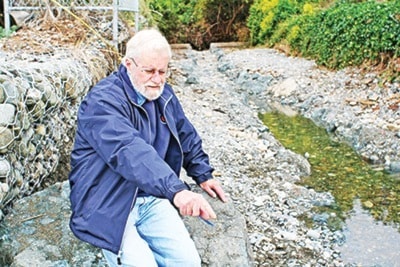Fish trying to access the sea from Nash Creek will now be able to make the journey.
The creek in Bowser is one of six in that area being worked on by the Nile Creek Enhancement Society (NCES) and a number of partners, to clear cobble and gravel at the mouths of the creek.
Historically there used to be huge numbers of coho salmon in the area, said Ken Kirkby, president of NCES, and the impediments represent one of the reasons there has been declining numbers.
Severe winter storms in the area produce a tremendous amount of debris, such as logs and rocks, that collect on the beach around these stream openings. The coho tend to come back to these small streams in December or January, Kirkby explained, when there is usually an early snow melt and the odd pineapple express that blows the mouths of the streams open.
"It allows fish to go up creek and spawn, then other storms come in afterwards and block it," he said. "Therefore, when the fish hatch, and they're smolts, and they (try to) go to sea, they can't."
In the past, NCES has been rescuing the salmon by trapping them and transferring them to the ocean via Nile Creek, but it was getting to be "a bit much" Kirkby said, as volunteers are aging among other challenges.
The group has had great support from the community, Kirkby said, and now funders and partners have also assisted the group in its endeavours to clear the streams, build stable stream beds, and employ measures to ensure they don't become blocked again anytime soon.
Trout Unlimited Canada, the Pacific Salmon Foundation, Vancouver Island University, LGL consultants and the Royal Bank of Canada’s Blue Water Program have been instrumental in the project, said Kirkby.
Nash Creek was completed earlier this month, the second such stream to be worked on in the area.
That project alone cost about $35,000.
Kirkby said the work is very rewarding as it is everyone’s job to ensure this type of work gets done.
“It’s not just about fish, it’s about human beings,” he said.
NCES will work with its funders and partners to continue the work on the other streams next summer. NCES’ mission is to enhance and protect the fresh water and marine habitats that support salmonids along the east coast of the Island.
For more on NCES, to donate or join the team of volunteers visit
www.nilecreek.org or call:
250-757-8775.
